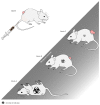Bacteria in Cancer Therapy: Renaissance of an Old Concept
- PMID: 27051423
- PMCID: PMC4802035
- DOI: 10.1155/2016/8451728
Bacteria in Cancer Therapy: Renaissance of an Old Concept
Abstract
The rising incidence of cancer cases worldwide generates an urgent need of novel treatment options. Applying bacteria may represent a valuable therapeutic variant that is intensively investigated nowadays. Interestingly, the idea to apply bacteria wittingly or unwittingly dates back to ancient times and was revived in the 19th century mainly by the pioneer William Coley. This review summarizes and compares the results of the past 150 years in bacteria mediated tumor therapy from preclinical to clinical studies. Lessons we have learned from the past provide a solid foundation on which to base future efforts. In this regard, several perspectives are discussed by which bacteria in addition to their intrinsic antitumor effect can be used as vector systems that shuttle therapeutic compounds into the tumor. Strategic solutions like these provide a sound and more apt exploitation of bacteria that may overcome limitations of conventional therapies.
Figures



Comment in
-
Comment on "Bacteria in Cancer Therapy: Renaissance of an Old Concept".Int J Microbiol. 2016;2016:6304150. doi: 10.1155/2016/6304150. Epub 2016 Sep 14. Int J Microbiol. 2016. PMID: 27703481 Free PMC article. No abstract available.
References
-
- Howlader N., Noone A., Krapcho M., et al. SEER Cancer Statistics Review, 1975—2012. Bethesda, Md, USA: National Cancer Institute; 2014.
Publication types
LinkOut - more resources
Full Text Sources
Other Literature Sources
Miscellaneous

